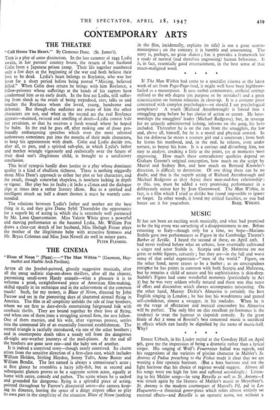THE CINEMA
AFTER all the Jezebel-painted, glossily suggestive musicals, after all the smug sadc slap-me-down thrillers, after all the chintzy, patronising small-town Hardy annuals—what a pleasure it is to welcome a good, straightforward piece of American film-making, skilful equally in its technique and in the achievement of the common touch! Such, for my money, is Blaze of Noon, directed by John Farrow and set in the pioneering days of chartered airmail flying in America. The film in all simplicity unfolds the tale of four brothers, whom we see first as dare-devils entertaining fairground folk with aerobatic thrills. They are bound together by their love of flying, and when one of them joins a struggling airmail firm, the rest follow. One of them marries, and his wife, after vigorous protest, settles into the communal life of an essentially fraternal establishment. The eternal triangle is tactfully introduced, via one of the other brothers ; and in counterpoint death takes a steady toll from the dangerous all-night any-weather journeys of the mail-planes. At the end all the brothers are gone save one—and the baby son of another. It is indeed a contrived story—though neatly contrived. Its charm arises from the sensitive direction of a first-class-cast, which includes William Holden, Stirling Hayden' Sonny Tufts, Anne Baxter and William Bendix. The last named is always a connoisseur's actor ; at first glance he resembles a hairy jelly-fish, but at second and subsequent glances proves to be a supreme screen actor, equally at home with satire, comedy and pathos. The scene where he is sacked and grounded for dangerous flying is a splendid piece of acting, pointed throughout by Farrow's directorial sense—the camera keep- ing its distance, leaving the space of a dingy airport office to play its own part in the simplicity of the situation. Blaze of Noon (nothing
in the film, incidentally, explains its title) is not a great screen- masterpiece ; on the contrary it is humble and unassuming. The story is, perhaps, no great shakes ; but it provides a framework for a study of normal (and therefore engrossing) human behaviour. It is, in fact, essentially good entertainment, in the best sense of that much-maligned word.
If The Man Within had come to a specialist cinema as the latest work of art from Pago-Pago -land, it might well have been highbrow- hailed as a masterpiece. It uses verbal commentary, artificial settings stylised to the nth degree (on purpose or by mistake?) and a great concentration on human relations in close-up. It is a costume piece concerned with complex psychologies—or should I say psychological complexes? A youth (Richard Attenborough) is forced into a smuggling gang before he has choice of action or career. He hero- worships the smugglers' leader (Michael Redgrave), but, in revenge for an unjustly administered lashing, informs on the gang, his hero included. Thereafter he is on the run from the smugglers, the law and, above all, himself, for he is a moral and physical coward. In his via dolorosa he meets a country girl and a courtesan ; from both he learnS his manhood, and, in the end, he refuses, even under torture, to betray his hero. It is a curious and disturbing film, not easy to analyse. creaking a little at the joints, yet at moments most engrossing. How much these contradictory qualities depend on Graham Greene's original conception, how much on the script by Muriel and Sydney Box, and how much on Bernard Knowles's direction, is difficult to determine. Of one thing there can be no doubt, and that is the superb acting of Richard Attenborough and Michael Redgrave as they depict their man-and-boy relationship ; to this, too, must be added a very promising performance in a deliberately minor key by Joan Greenwood. The Man Within, in fact, is a film which I tried to dislike but found impossible to ignore or forget. In other words, it foxed my critical faculties, so you had


































 Previous page
Previous page